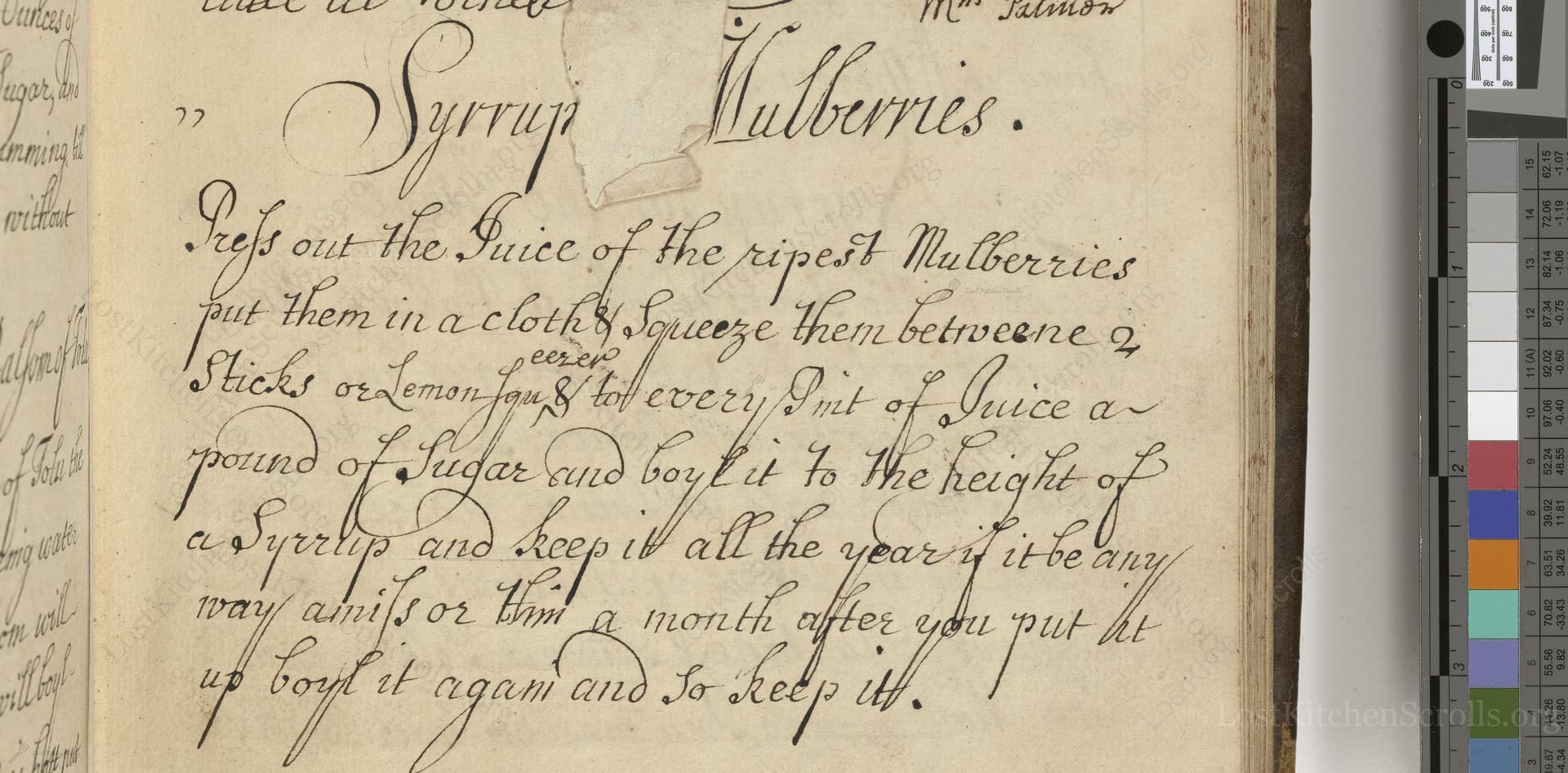
Syrrup Mullberries
"Prefs out the Juice of the ripest Mullberries put them in a cloth & Squeeze them between 2 Sticks or Lemon for & to every Pint of Juice a pound of Sugar and boyl it to the height of a Syrrup and keep it all the year if it be any way amiss or than a month after you put it up boyl it again and So keep it."
Note on the Original Text
The original recipe is concise and assumes the cook's familiarity with basic kitchen processes, hence the lack of specific times or temperatures. The spelling is of its era ('boyl' for 'boil', 'syrrup' for 'syrup', 'prefs' for 'press', 'mullberries' for 'mulberries'), reflecting the absence of standardized spelling in 1680. Instructions like 'to the height of a Syrrup' refer to boiling the mixture until it reaches the desired syrupy consistency—a common, intuitive standard before sugar thermometers.

Title
Cordial waters simple waters and syrrups (1680)
You can also click the book image above to peruse the original tome
Writer
Unknown
Era
1680
Publisher
Unknown
Background
Step back to the kitchens of the 17th century with this delightful collection of time-honored recipes and culinary secrets, sure to enchant any lover of historical gastronomy.
Kindly made available by
Folger Shakespeare Library
This recipe for 'Syrrup Mullberries' originates from a household manuscript dated to 1680, a time when fruit syrups were prized both for medicinal and culinary uses. In 17th-century England, sugar syrups made with summer berries offered not only vibrant flavors but also a means to preserve the fleeting harvest. Recipes like this would have been made by well-to-do households looking to stock their larders with healthful, restorative cordials, believed to soothe sore throats or quench thirst, as well as to flavor water, wine, or puddings throughout the year.

Historically, the juice would have been pressed from the berries using a simple cloth and two sticks twisted together, or perhaps with the aid of a lemon press or simple hand juicer. Large copper or brass pans set over the hearth were used to boil the juice and sugar mixture. Storage would have involved glass bottles or earthenware jars sealed with paper and wax or bladder, to keep the syrup shelf-stable through the year.
Prep Time
10 mins
Cook Time
15 mins
Servings
10
We've done our best to adapt this historical recipe for modern kitchens, but some details may still need refinement. We warmly welcome feedback from fellow cooks and culinary historians — your insights support the entire community!
Ingredients
- 2 cups fresh ripe mulberries (or substitute blackberries if mulberries are unavailable)
- 2 cups granulated sugar
Instructions
- To make Mulberry Syrup in the modern kitchen, begin by taking ripe mulberries—fresh and fully colored.
- Rinse them gently, then place them in a clean cheesecloth or nut milk bag.
- Instead of squeezing between two sticks or with a lemon as in the original method, you can press them with a potato masher or use a citrus press to extract the juice over a bowl.
- For every 2 cups of mulberry juice you obtain, weigh out 2 cups of granulated sugar.
- Pour both the juice and sugar into a pot, stir to combine, and bring to a gentle boil over medium heat, skimming off any foam.
- Simmer until the syrup thickens slightly—this usually takes about 10–15 minutes.
- Allow to cool, then bottle in sterilized jars.
- If you notice any signs of spoilage during storage, reboil to preserve it further.
Estimated Calories
150 per serving
Cooking Estimates
You will need about 10 minutes to prepare the mulberries and extract the juice. Cooking the syrup until it thickens takes around 15 minutes. This recipe yields about 10 servings, and each serving contains roughly 150 calories.
As noted above, we have made our best effort to translate and adapt this historical recipe for modern kitchens, taking into account ingredients nowadays, cooking techniques, measurements, and so on. However, historical recipes often contain assumptions that require interpretation.
We'd love for anyone to help improve these adaptations. Community contributions are highly welcome. If you have suggestions, corrections, or cooking tips based on your experience with this recipe, please share them below.
Join the Discussion
Rate This Recipe
Dietary Preference
Main Ingredients
Culinary Technique

Den Bockfisch In Einer Fleisch Suppen Zu Kochen
This recipe hails from a German manuscript cookbook compiled in 1696, a time whe...

Die Grieß Nudlen Zumachen
This recipe comes from a rather mysterious manuscript cookbook, penned anonymous...

Ein Boudain
This recipe comes from an anonymous German-language manuscript cookbook from 169...

Ein Gesaltzen Citroni
This recipe, dating from 1696, comes from an extensive anonymous German cookbook...
Browse our complete collection of time-honored recipes



